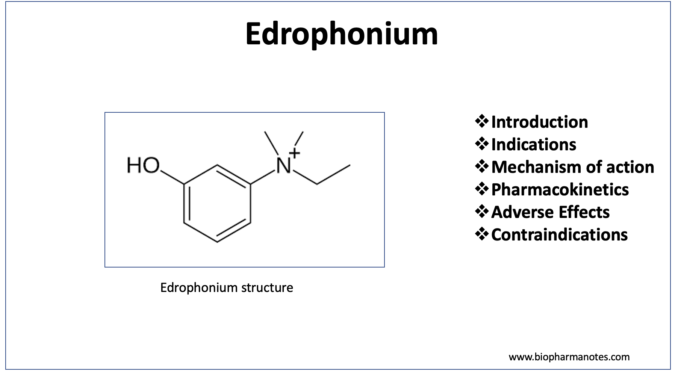
- Edrophonium is short acting and reversible acetylcholinesterase (AChE) inhibitor. It’s use is limited nowadays due to development and availability of other agents.
Indications of edrophonium
- Used in reversal of non- depolarizing neuromuscular blocking agents (NMBA) after a surgical procedure. For this purpose, it is either used simultaneously with atropine or few minutes after administration of glycopyrrolate.
- In adjunctive treatment of respiratory depression caused by curare overdosage.
- Used in diagnosis and evaluation of myasthenia gravis (MG). It helps to differentiate between myasthenia gravis and cholinergic crisis. It is used for evaluating emergency treatment in myasthenia gravis. Myasthenia gravis is neuromuscular disease characterized by muscular weakness. However, in 2018 it’s use was discontinued by FDA due to high rate of false positive results and development of serological antibody testing.
Mechanism of action of edrophonium
- Acetylcholinesterase is the enzyme involved in cleavage of acetylcholine. Acetylcholine (ACh) is an organic chemical that function in the body as neurotransmitter. It is synthesized and stored in presynaptic neurons of NMJ (Neuromuscular junction). The released Ach bind to post synaptic cholinergic receptors i.e., Muscarinic and Nicotinic receptors.
- Edrophonium competitively inhibits acetylcholinesterase enzyme by forming non- covalent bonds at the serine 103- allosteric site of AChE. This leads to increase in amount of ACh in neuromuscular junction synapses leading to increased cholinergic response.
- Increased concentration of ACh in NMJ help to overcome antibodies on nicotinic receptors in case of MG and results in improvement of muscular strength.
Pharmacokinetics of edrophonium
- It is used by IV route and has rapid onset of action. It starts acting within 1 minute of administration and its action lasts for around 10-20 minutes.
- Its distribution half-life is around 7-12 minutes and elimination half-life is around 33-110 minutes. It undergoes rapid renal excretion.
Adverse effects
- Most of its side effects are due to the action of increased concentration of ACh on muscarinic receptors. Some serious side effects are bradycardia, cardiac arrhythmia, cardiac arrest, AV block, bronchoconstriction etc. To prevent the risk of bradycardia, it is administered simultaneously with atropine or few minutes after glycopyrrolate while using for NMBA reversal.
- It can also cause other muscarinic like symptoms which include increase in bronchial secretions, lacrimation, salivation, sweating, diarrhea, nausea, and vomiting. The increase in bronchial secretion can cause obstruction of airway.
- Most of its side effects can be counteracted by use of atropine.
Contraindication
- Contraindicated in patients with known hypersensitivity to edrophonium.
- Contraindicated in patients with gastrointestinal or urinary obstruction.
- It should be used with care and regular monitoring is needed when administering in patients with asthma and cardiac arrhythmia.
- When using for non- depolarizing NMBA reversal, it is contraindicated when peripheral nerve stimulation doesn’t elicit at least one twitch.
References
- https://www.ncbi.nlm.nih.gov/books/NBK554566/
- https://go.drugbank.com/drugs/DB01010
- https://tmedweb.tulane.edu/pharmwiki/doku.php/edrophonium
- https://www.drugs.com/ppa/edrophonium-and-atropine.html#pharmacology
- Goodman and Gillman Manual of Pharmacology and Therapeutics.
- Lippincott Illustrated Reviews Pharmacology, 6th edition